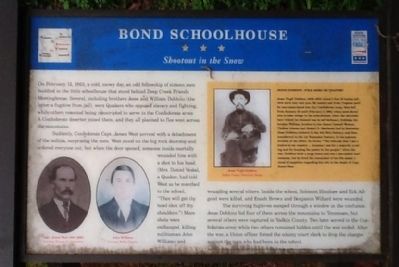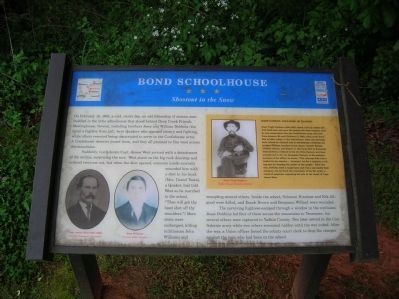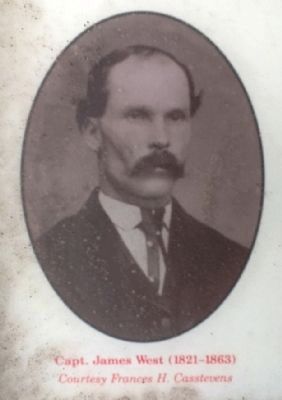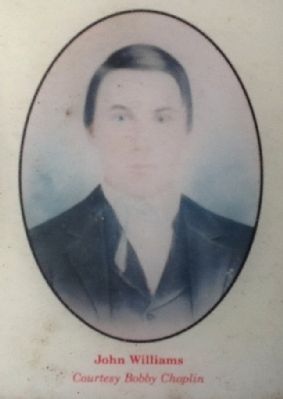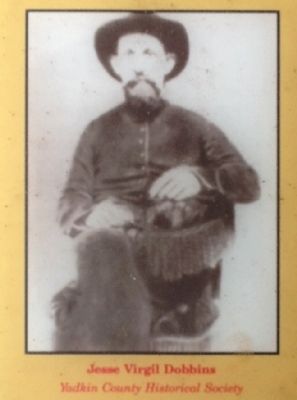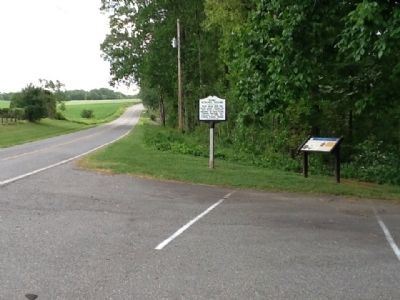Near Yadkinville in Yadkin County, North Carolina — The American South (South Atlantic)
Bond Schoolhouse
Shootout in the Snow
Suddenly, Confederate Capt. James West arrived with a detachment of the militia, surprising the men. West stood on the big rock doorstep and ordered everyone out, but when the door opened, someone mortally wounded him with a shot to the head. (Mrs. Daniel Vestal, a Quaker, had told West as he marched to the school, "Thee will get thy head shot off thy shoulders.") More shots were exchanged, killing militiaman John Williams and wounding several other. Inside the school, Solomon Hinshaw and Eck Allgood were killed, and Enoch Brown and Benjamin Willard were wounded.
The surviving fugitives escaped through a window in the confusion. Jesse Dobbins led four of them across the mountains to Tennessee, but several others were captured in Yadkin County. Two later served in the Confederate army while two others remained hidden until the war ended. After the war, a Union officer forced the county clerk to drop the charges against the men who had been in the school.
[Inset]:
Jesse Dobbins—Folk Hero or Traitor?
Jesse Virgil Dobbins (1830-1883) stood 5 feet 10 inches tall with dark hair and eyes. He hauled salt from Virginia until he was conscripted into the Confederate army, then hid from January 20 until February 1, 1863, when snow drove him to take refuge in the schoolhouse. After the skirmish here (which he claimed was in self-defense), Dobbins, his brother William, brother-in-law James Caswell Wooten, Thomas Adams, and Robert E. Hutchens fled to Kentucky. Jesse Dobbins enlisted in the 4th Ohio Battery, and then transferred to the 1st Tennessee Battery. In his post-war account of the affair, he wrote: "The rebs say that I am a traitor to my country ... because I am for a majority a-ruling and for keeping the power in the people." After the war, Dobbins built a large home and was a successful businessman, but he lived the remainder of his life under a cloud of suspicion regarding his role in the death of Capt. James West.
Erected by Civil War Trails.
Topics and series. This historical marker is listed in this topic list: War, US Civil. In addition, it is included in the North Carolina Civil War Trails, and the Quakerism series lists. A significant historical month for this entry is January 1892.
Location. 36° 10.92′ N, 80° 39.06′ W. Marker is near Yadkinville, North Carolina, in Yadkin County. Marker is on Deep Creek Church Road, on the right when traveling east. Touch for map. Marker is in this post office area: Yadkinville NC 27055, United States of America. Touch for directions.
Other nearby markers. At least 8 other markers are within 7 miles of this marker, measured as the crow flies. Bond School House (a few steps from this marker); Deep Creek Friends Meeting (within shouting distance of this marker); Second Yadkin County Jail (approx. 3.2 miles away); Yadkinville (approx. 3.2 miles away); Richmond Pearson (approx. 4.1 miles away); Rockford (approx. 6.1 miles away); Richmond Hill (approx. 6.3 miles away); a different marker also named Richmond Hill (approx. 6.3 miles away). Touch for a list and map of all markers in Yadkinville.
Credits. This page was last revised on June 16, 2016. It was originally submitted on April 20, 2012, by Michael C. Wilcox of Winston-Salem, North Carolina. This page has been viewed 2,179 times since then and 107 times this year. Photos: 1, 2, 3, 4, 5, 6. submitted on April 20, 2012, by Michael C. Wilcox of Winston-Salem, North Carolina. • Craig Swain was the editor who published this page.
